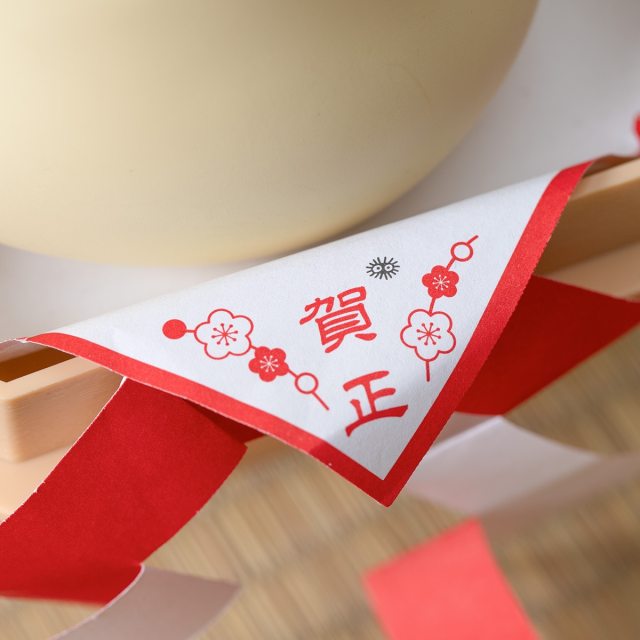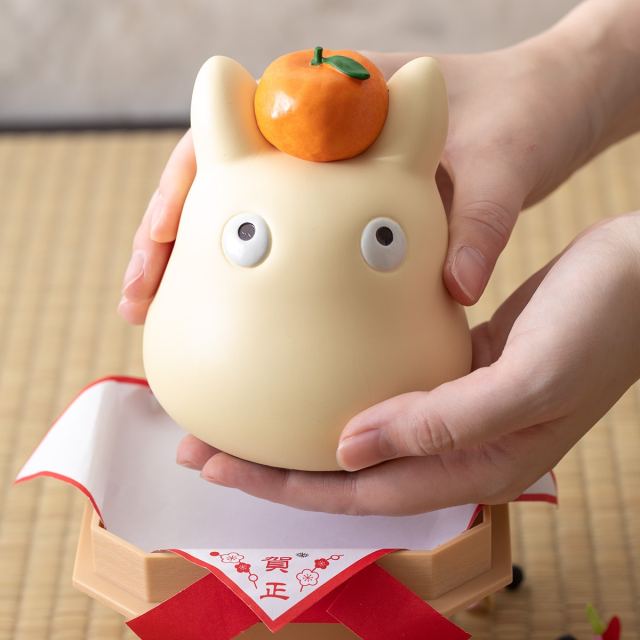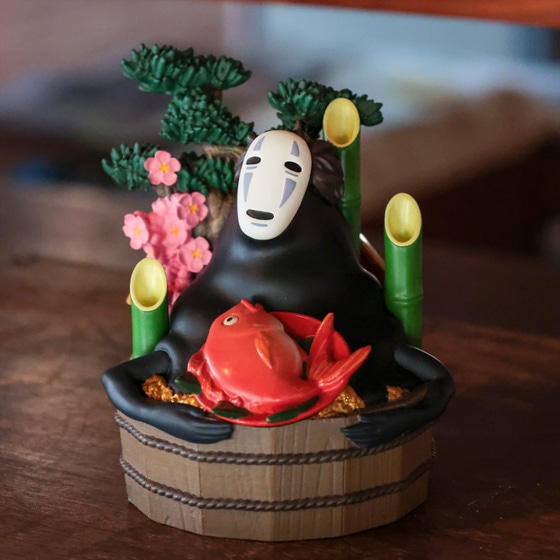
Totoro, Jiji and No Face bring anime charm to some traditional customs.
It’s often been said that the most traditional time of year in Japan is New Year’s, when people take part in a wide variety of customs that include visiting shrines and temples, eating special foods, and decorating their homes with traditional displays to usher in good luck.
One of the most common displays you’ll find in a lot of homes is the kagami mochi (literally “mirror rice cake”), which consists of two mounds of mochi placed on top of each other, with a Japanese citrus fruit called “daidai” on top. The shape of the rice cakes is said to represent the mirror of the sun goddess Amaterasu, one of Japan’s most sacred items, so the display is usually placed on a traditional sheet of paper called shihobeni and displayed on a small pedestal known as a sanpo, in a similar manner to the way offerings are presented to the gods on an altar in a Shinto shrine.
▼ An example of kagami-mochi, albeit without the traditional pedestal.
These days, kagami mochi are displayed in a number of ways, but the main elements of plump white rice cakes and citrus topping, complete with green leaf attached, generally remain the same. That is, unless you’re Studio Ghibli, because this year they’re giving us a kagami mochi like nothing we’ve ever seen before, replacing the mochi cakes with the body of a Totoro!
If you like your decorations to be soft and cuddly, you’ll love the New Year’s Small Totoro plushie, which is 12 centimetres (4.7 inches) wide and 10 centimetres tall, and retails for 2,200 yen (US$14.78).
Those looking for a slightly more traditional decoration will want to opt for the New Year’s Small Totoro made from polyester resin, making it firmer to touch.
This Totoro comes with the traditional paper and stand, although these ones are embellished with some gorgeous Ghibli details.
The red-and-white paper reads “Gasho” (“Happy New Year”) on the front corner, with plum blossoms to represent the coming of spring and new beginnings, and a little Soot Sprite to give it a dash of Ghibli magic.
The pedestal, which traditionally features a hole in the shape of a Hoju (a sacred, wish-fulfilling jewel), bears the shape of Totoro instead.
This Totoro is 9.5 centimetres wide and 11 centimetres tall and weighs in at 761 grams (26.8 ounces).
▼ At 6,930 yen, it’s more expensive than the plush Totoro, but it does come with a stand and paper decoration, making for a more impressive display.
Fans of Kiki’s Delivery Service also have cause to celebrate, with the unveiling of a wreath featuring magical black cat Jiji.
While it’s customary to display a wreath or pine display at your front door over New Year’s in Japan, this Ghibli item is described as a “Western-style decoration” due to its design, which doesn’t include sacred paper details and opts for a more subdued hue that’s markedly different to that of traditional Japanese New Year’s wreaths.
A traditional wreath, known as “shime kazari”, contains bursts of green and red hues, with leaves of urajiro (Japanese fern) and yuzuriha (false daphne) often included.
The Ghibli wreath has a similar straw rope but different details that hark back to the medicinal herbs and blooms seen in Kiki’s family home, where magical potions are concocted.
If you’re more of a Spirited Away fan, you’ll want to check out this New Year’s decoration featuring No Face, which retails for 8,800 yen.
This beautiful item gives us a Ghibli twist on the traditional kadomatsu display, which contains pine and bamboo and usually looks similar to what we see in the image below.
▼ Miniature kadomatsu
While most kadomatsu are large and purchased as a pair, with one placed on either side of the door, that’s not an option for apartment dwellers who usually have to keep shared public spaces clear of clutter, so mini versions like this one bring the tradition indoors.
▼ Ah…ah…ah…
There are a lot of auspicious items to be found in No Face’s tub, starting with the pine, bamboo and plum display, which also includes a fan in a mound of gold.
The auspicious gold and red hues continue on the front, where we see a tai in a plate perched on No Face’s belly. Tai, or red sea bream, is one of the lucky foods eaten at New Year.
Not only will this decoration help to bring luck and fortune into your home, it can also serve as a reminder to avoid greed and overindulging during the holiday period and the year ahead, lest we end up like No Face in the bathhouse.
While the No Face decoration, in true No Face fashion, has been lurking on the Donguri Kyowakoku site for a while now, the Totoro and Jiji decorations are new additions to the range for New Year.
On sale online from 25 November, the newly released Jiji and larger Totoro items proved to be sell-out hits, with only the small plush Totoro now remaining in stock. Donguri Kyowakoku is known to restock its popular goods whenever possible, though, so here’s hoping they’ll have more available before the year is out. Until then, we’ll be browsing these New Year’s Totoro tenugui decorations and the cute new Ghibli hanko stamps in the lead-up to the holidays.
Source: Donguri Kyowakoku
Featured image: Donguri Kyowakoku
Insert images: Pakutaso (1, 2, 3) Donguri Kyowakoku (1, 2, 3, 4)
● Want to hear about SoraNews24’s latest articles as soon as they’re published? Follow us on Facebook and Twitter!




















 Studio Ghibli releases traditional New Year decorations with My Neighbour Totoro characters
Studio Ghibli releases traditional New Year decorations with My Neighbour Totoro characters Usher good luck into your home this New Year with Totoro tenugui from Studio Ghibli
Usher good luck into your home this New Year with Totoro tenugui from Studio Ghibli Have you ever noticed how much Totoro looks like New Year’s mochi? This plushie’s designers did, and the result is adorable!
Have you ever noticed how much Totoro looks like New Year’s mochi? This plushie’s designers did, and the result is adorable! Ghibli New Year’s Totoro decoration sells out online, but there’s still a way you can get one
Ghibli New Year’s Totoro decoration sells out online, but there’s still a way you can get one Studio Ghibli holiday wreath adds a touch of Kiki cuteness and good fortune to your home【Photos】
Studio Ghibli holiday wreath adds a touch of Kiki cuteness and good fortune to your home【Photos】 Rakuten randomly offers 58 New Year’s osechi feasts in Japan, but did we get a star or a dud?
Rakuten randomly offers 58 New Year’s osechi feasts in Japan, but did we get a star or a dud? Starbucks Japan ready to get Year of the Horse started with adorable drinkware and plushies【Pics】
Starbucks Japan ready to get Year of the Horse started with adorable drinkware and plushies【Pics】 Tokyo accommodation: Capsule hotel offers unique sleep and sauna stay for women
Tokyo accommodation: Capsule hotel offers unique sleep and sauna stay for women What does a kanji with 12 “kuchi” radicals mean? A look at weird, forgotten Japanese characters
What does a kanji with 12 “kuchi” radicals mean? A look at weird, forgotten Japanese characters Japanese man gets fired for lying on resume by saying he had less education than he really does
Japanese man gets fired for lying on resume by saying he had less education than he really does Original Totoro plush toys from 80s and 90s re-issued for Studio Ghibli exhibition
Original Totoro plush toys from 80s and 90s re-issued for Studio Ghibli exhibition Super Budget Dining in Japan – What’s the best way to spend 1,000 yen (US$6.70) at Saizeriya?
Super Budget Dining in Japan – What’s the best way to spend 1,000 yen (US$6.70) at Saizeriya? Dragon Quest Burgers and Slime drinks are coming to McDonald’s Japan【Video】
Dragon Quest Burgers and Slime drinks are coming to McDonald’s Japan【Video】 More people in Japan quit sending New Year’s cards and many have started to regret it
More people in Japan quit sending New Year’s cards and many have started to regret it Exhibit featuring cutting-edge smell technology held at Tokyo Skytree
Exhibit featuring cutting-edge smell technology held at Tokyo Skytree Hayao Miyazaki says Happy New Year to Studio Ghibli fans with new art for Year of the Horse
Hayao Miyazaki says Happy New Year to Studio Ghibli fans with new art for Year of the Horse Japanese beef bowl chain Sukiya’s 2026 Smile Box lucky bag basically pays for itself
Japanese beef bowl chain Sukiya’s 2026 Smile Box lucky bag basically pays for itself We found possibly the quietest Japanese-style hotel in Tokyo’s bustling Shinjuku district
We found possibly the quietest Japanese-style hotel in Tokyo’s bustling Shinjuku district Cup Noodle tries an authentic Jiro-style ramen, but something’s not quite right
Cup Noodle tries an authentic Jiro-style ramen, but something’s not quite right The best Starbucks Japan Frappuccinos we want to drink again in 2026
The best Starbucks Japan Frappuccinos we want to drink again in 2026 We revisited Sweets Paradise after a decade to see if Japan’s dessert buffet still delivers
We revisited Sweets Paradise after a decade to see if Japan’s dessert buffet still delivers That time Seiji called JASRAC to ask why he didn’t get paid royalties for his song being on TV
That time Seiji called JASRAC to ask why he didn’t get paid royalties for his song being on TV Japan’s oldest largetooth sawfish in captivity back on display in Mie Prefecture
Japan’s oldest largetooth sawfish in captivity back on display in Mie Prefecture Pizza Hut Japan’s hot lucky bags are perfect for a New Year’s pizza party
Pizza Hut Japan’s hot lucky bags are perfect for a New Year’s pizza party 7-Eleven Japan starts new temporary luggage storage service in over 300 branches
7-Eleven Japan starts new temporary luggage storage service in over 300 branches Disillusionment at Tsukiji’s tourist-target prices led us to a great ramen restaurant in Tokyo
Disillusionment at Tsukiji’s tourist-target prices led us to a great ramen restaurant in Tokyo Starbucks teams up with 166-year-old Kyoto doll maker for Year of the Horse decorations【Photos】
Starbucks teams up with 166-year-old Kyoto doll maker for Year of the Horse decorations【Photos】 Tokyo considering law requiring more trash cans following litter increase in heavily touristed area
Tokyo considering law requiring more trash cans following litter increase in heavily touristed area Tokyo’s Tsukiji sushi neighborhood asks tour groups to stay away for the rest of the month
Tokyo’s Tsukiji sushi neighborhood asks tour groups to stay away for the rest of the month Tokyo event lets you travel back in time, for free, to celebrate 100 years since Showa era start
Tokyo event lets you travel back in time, for free, to celebrate 100 years since Showa era start Japan may add Japanese language proficiency, lifestyle classes to permanent foreign resident requirements
Japan may add Japanese language proficiency, lifestyle classes to permanent foreign resident requirements Sanrio theme park in Japan announces plans to expand into a Sanrio resort
Sanrio theme park in Japan announces plans to expand into a Sanrio resort Stamina-destroying “Paralysis Noodles” are Tokyo’s newest over-the-top ramen innovation
Stamina-destroying “Paralysis Noodles” are Tokyo’s newest over-the-top ramen innovation Survey asks foreign tourists what bothered them in Japan, more than half gave same answer
Survey asks foreign tourists what bothered them in Japan, more than half gave same answer Japan’s human washing machines will go on sale to general public, demos to be held in Tokyo
Japan’s human washing machines will go on sale to general public, demos to be held in Tokyo Japan’s deadliest food claims more victims, but why do people keep eating it for New Year’s?
Japan’s deadliest food claims more victims, but why do people keep eating it for New Year’s? We deeply regret going into this tunnel on our walk in the mountains of Japan
We deeply regret going into this tunnel on our walk in the mountains of Japan Studio Ghibli releases Kodama forest spirits from Princess Mononoke to light up your home
Studio Ghibli releases Kodama forest spirits from Princess Mononoke to light up your home Major Japanese hotel chain says reservations via overseas booking sites may not be valid
Major Japanese hotel chain says reservations via overseas booking sites may not be valid Put sesame oil in your coffee? Japanese maker says it’s the best way to start your day【Taste test】
Put sesame oil in your coffee? Japanese maker says it’s the best way to start your day【Taste test】 No more using real katana for tourism activities, Japan’s National Police Agency says
No more using real katana for tourism activities, Japan’s National Police Agency says Starbucks Japan reveals new sakura drinkware collection, inspired by evening cherry blossoms
Starbucks Japan reveals new sakura drinkware collection, inspired by evening cherry blossoms Updated cherry blossom forecast shows extra-long sakura season for Japan this year
Updated cherry blossom forecast shows extra-long sakura season for Japan this year Studio Ghibli releases New Year’s stamps for 2024
Studio Ghibli releases New Year’s stamps for 2024 Studio Ghibli’s Mother’s Day corn set is a heartwarming gift for Totoro fans
Studio Ghibli’s Mother’s Day corn set is a heartwarming gift for Totoro fans Studio Ghibli releases new Panda! Go, Panda! goods for New Year
Studio Ghibli releases new Panda! Go, Panda! goods for New Year Studio Ghibli releases new plush toy backpacks for adults and children
Studio Ghibli releases new plush toy backpacks for adults and children Studio Ghibli summer merchandise puts famous anime characters on Japanese fans and wind chimes
Studio Ghibli summer merchandise puts famous anime characters on Japanese fans and wind chimes Totoro, Spirited Away tenugui tapestries promise good luck at New Year’s, smiles all the time【Pics】
Totoro, Spirited Away tenugui tapestries promise good luck at New Year’s, smiles all the time【Pics】 Studio Ghibli releases Mini Mini Stamp sets featuring top anime characters
Studio Ghibli releases Mini Mini Stamp sets featuring top anime characters Studio Ghibli makes every day magical with new Spirited Away, Totoro and Kiki calendars
Studio Ghibli makes every day magical with new Spirited Away, Totoro and Kiki calendars Traditional Japanese New Year’s decorations with a Mad Max theme? WHAT A LOVELY DAY!
Traditional Japanese New Year’s decorations with a Mad Max theme? WHAT A LOVELY DAY! Studio Ghibli celebrates New Year with a fukubukuro lucky bag packed with anime merchandise
Studio Ghibli celebrates New Year with a fukubukuro lucky bag packed with anime merchandise Studio Ghibli releases new anime tea and mugs in Japan
Studio Ghibli releases new anime tea and mugs in Japan Studio Ghibli releases new anime envelopes in Japan with interactive features
Studio Ghibli releases new anime envelopes in Japan with interactive features Studio Ghibli releases cute new blanket socks for winter
Studio Ghibli releases cute new blanket socks for winter Studio Ghibli releases new mug and tumbler collection featuring Jiji and Totoro
Studio Ghibli releases new mug and tumbler collection featuring Jiji and Totoro Studio Ghibli adds My Neighbour Totoro stamps to its anime merchandise store in Japan
Studio Ghibli adds My Neighbour Totoro stamps to its anime merchandise store in Japan Studio Ghibli releases new anime cushions for Totoro and Kiki’s Delivery Service fans
Studio Ghibli releases new anime cushions for Totoro and Kiki’s Delivery Service fans
Leave a Reply